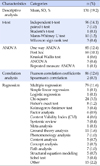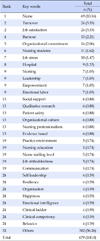Abstract
Purpose
This study aimed to identify research trends in the Journal of Korean Academy of Nursing Administration from 2013 to 2015.
Methods
For this study, 171 articles were analyzed. Research designs, participants, research settings, sampling, and data analyses methods were reviewed using established analysis criteria. Keyword centrality and clusters were generated by keyword network analysis.
Results
Most of studies used quantitative methods (82.5%), and sampling mainly focused on nurses (68.8%). The most commonly used data analyses methods were t-test, ANOVA, correlation, and regression. The most central keywords were turnover and empowerment. Network analysis generated four network groups: 1) burnout; 2) turnover; 3) happiness; and 4) nursing professionalism.
Figures and Tables
References
1. Kim JH, Choi HN, Kang MS, Choi SH, Kim BK, Seo SK, et al. Korea Journal Citation Report KJCR 2015 [Internet]. Daejeon: Korea Institute of Science and Technology Information;2015. cited 2016 December 23. Available from: http://ksci.kisti.re.kr/source/image/publications/KJCR2015.pdf.
2. National Research Foundation of Korea. 2015 Journal evaluation excellent registered journal announcement [Internet]. Daejeon: National Research Foundation of Korea;2015. updated 2015, August 24. cited 2016 December 23. Available from: http://www.nrf.re.kr/nrf_tot_cms/board/biz_notice/view.jsp?show_no=170&check_no=169&c_relation=biz&c_relation2=0&c_no=8&c_now_tab=1&BBS_LLF_CD=biznot&BBS_SLF_CD=8&NTS_NO=67777.
3. Suh YO, Park JS, Yang JH, Kim HW, Suk MH, Shin HS, et al. Analysis of research papers published in the Journal of Korean Academy of Nursing. J Korean Acad Nurs. 2007; 37(6):1013–1019.
4. Koh MS, Ha NS. Review of the Journal of Korean Nursing Administration Academic Society and its research trends. J Korean Acad Nurs Adm. 2001; 7(3):561–569.
5. Seomun G, Koh MS. Academic value and outcome of the Journal of Korean Academy of Nursing Administration. J Korean Acad Nurs Adm. 2007; 13(4):546–552.
6. Seomun G, Kim IA, Koh MS. Classification of keywords of the papers from the Journal of Korean Academy of Nursing Administration(2002-2006). J Korean Acad Nurs Adm. 2007; 13(1):118–122.
7. Kim JK, Jung MS, Jang KS, Kim J, Kim EK, Lee H, et al. Analysis of the Journal of Korean Academy of Nursing Administration for 3 Years (2007-2009). J Korean Acad Nurs Adm. 2010; 16(4):517–526. DOI: 10.11111/jkana.2010.16.4.517.
8. Jang KS, Kim BN, Kim YM, Kim JS, Jeong SH. Analysis of research articles published in the Journal of Korean Academy of Nursing Administration for 3 years (2010-2012). J Korean Acad Nurs Adm. 2013; 19(5):679–688. DOI: 10.11111/jkana.2013.19.5.679.
9. Kim K, Chang SO, Kang HS, Kim KS, Kim JI, Kim HS, et al. Trends in research studies published in Journal of Korean Academy of Fundamentals of Nursing: 2009-2011. J Korean Acad Fundam Nurs. 2012; 19(3):383–391. DOI: 10.7739/jkafn.2012.19.3.383.
10. Choi YC, Park SJ. Analysis of research trends in Korean public administration. Korean Public Adm Rev. 2011; 45(1):123–139.
11. Yoo HH, Shin S. Trends of research articles in the Korean Journal of Medical Education by social network analysis. Korean J Med Educ. 2015; 27(4):247–254. DOI: 10.3946/kjme.2015.27.4.247.
12. Jhang SE, Lee SH. A study of themes and trends in research of global maritime economics through keyword network analysis. J Korea Port Econ Assoc. 2016; 32(1):79–95.
13. Popping R. Computer-assisted text analysis. Thousand Oaks, CA: Sage Publications;2000.
14. Kang KH, Yu S. Analysis of students experience related of nursing management clinical practice: Text network analysis method. J Korean Acad Nurs Adm. 2016; 22(1):80–90. DOI: 10.11111/jkana.2016.22.1.80.
15. Kwon SY, Bae KR. A study on the knowledge structure of cancer survivors based on social network analysis. J Korean Acad Nurs. 2016; 46(1):50–58. DOI: 10.4040/jkan.2016.46.1.50.
16. Freeman LC. Centrality in social networks conceptual clarification. Soc Networks. 1978; 1(3):215–239. DOI: 10.1016/0378-8733(78)90021-7.
17. Wasserman S, Faust K. Social network analysis: Methods and applications. Structural analysis in the social sciences. vol 8. Cambridge: Cambridge University Press;1994.
18. Kho JC, Cho KT, Cho YH. A study on recent research trend in management of technology using keywords network analysis. J Intell Inf Syst. 2013; 19(2):101–123.
19. Park CS, Jung JW. Text network analysis: The identification shared meaning among policy stake-holders using socio-cognitive network analysis. J Gov Stud. 2013; 19(2):73–108.
20. Choe MA, Kim NC, Kim KM, Kim SJ, Park KS, Byeon YS, et al. Trends in nursing research in Korea: research trends for studies published from the inaugural issue to 2010 in the Journal of Korean Academy of Nursing and the journals published by member societies under Korean Academy of Nursing Science. J Korean Acad Nurs. 2014; 44(5):484–494. DOI: 10.4040/jkan.2014.44.5.484.
21. Kim JS, Lim JY, Kwon IS, Kim TI, Park HR, Ahn HY, et al. Analysis of research trends in papers published in the Journal of Korean Academy of Child Health Nursing (2005-2009). J Korean Acad Child Health Nurs. 2011; 17(2):100–110. DOI: 10.4094/jkachn.2011.17.2.100.
22. Lee HK, Yang YH, Koo MO, Eun Y. Introduction of nursing research. 4th ed. Seoul: Hyunmoonsa;2009.
23. Korean Hospital Nurses Association. A survey on hospital nursing staffing (2011). Business report for Hospital Nurses Association. Seoul: Korean Hospital Nurses Association;2012.
24. Korean Hospital Nurses Association. A survey on hospital nursing staffing (2013). Business report for Hospital Nurses Association. Seoul: Hospital Nurses Association;2013.
25. Korean Hospital Nurses Association. A survey on hospital nursing staffing(2015). Business report for Hospital Nurses Association. Seoul: Korean Hospital Nurses Association;2016.
26. Kim IS. Job sharing example of work-family balance type: Working condition of nurse manpower in medium and smallsized hospital. Mon Labor Rev. 2009; (53):16–26.
27. Yeun EJ, Kim HJ. Development and testing of a nurse turnover intention scale (NTIS). J Korean Acad Nurs. 2013; 43(2):256–266. DOI: 10.4040/jkan.2013.43.2.256.
28. Hayes LJ, O'Brien-Pallas L, Duffield C, Shamian J, Buchan J, Hughes F, et al. Nurse turnover: a literature review - an update. Int J Nurs Stud. 2012; 49(7):887–905. DOI: 10.1016/j.ijnurstu.2011.10.001.




 PDF
PDF ePub
ePub Citation
Citation Print
Print







 XML Download
XML Download